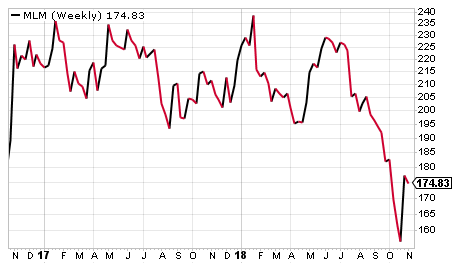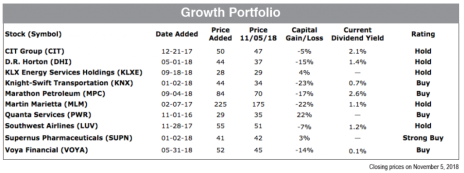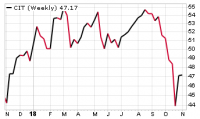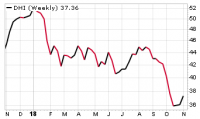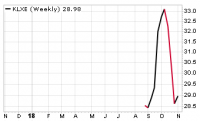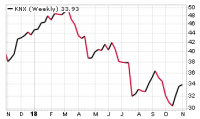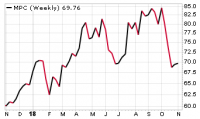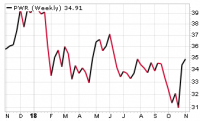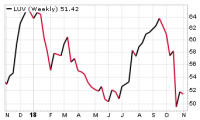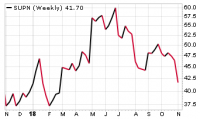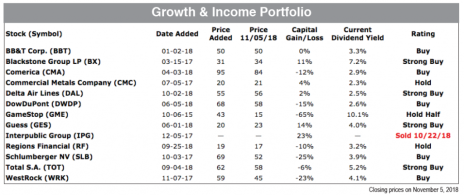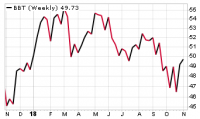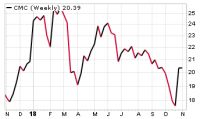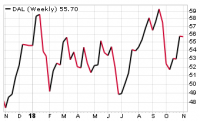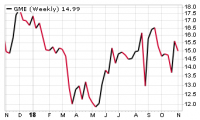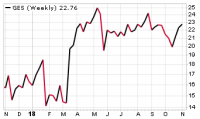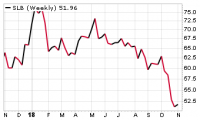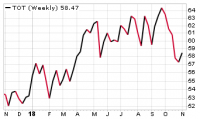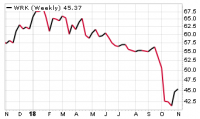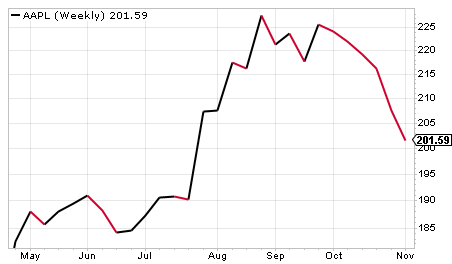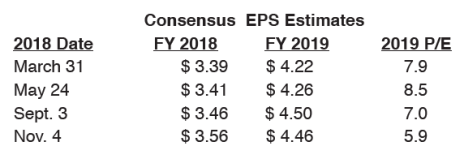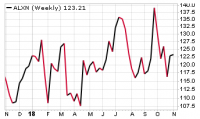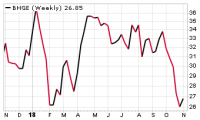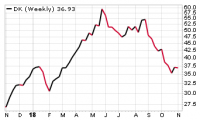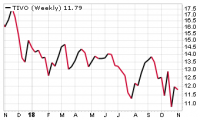The stock market continues to work its way through the second of two 10% corrections in 2018, as measured by performance of the S&P 500 index. On the bright side, the worst appears to be over for the majority of stocks that I follow. Exceptions will include stocks that are reaching annual lows. Unfortunately, those stocks will likely fall further until tax loss selling subsides.
I continue to expect many stocks to remain low through year end, possibly followed by quite a bull run in January.
Cabot Undervalued Stocks Advisor 1118
[premium_html_toc post_id="163476"]
Apple (AAPL) Redux
Welcome to November, holiday season, winter’s coming, and mid-term elections! As if a stock market correction wasn’t providing enough excitement…
Today I’m doing something slightly different. I normally feature one stock from each of our three portfolios in the monthly issue. Today two of those stocks come from the Buy Low Opportunities Portfolio. (After all, we’re in a market correction. “Buy low” would certainly be an appropriate theme, right?)
I’m pleased to announce that Apple (AAPL) is returning for an encore performance. Why search for hidden stock market bargains when my favorite stock just fell 10%? Every portfolio manager across the U.S. is aware of AAPL’s price action. I’m fairly certain many of them are ready to pounce on the stock!
I was hoping to pare back the Cabot Undervalued Stocks Advisor portfolios, and then infuse them with a fresh assortment of opportunities. The timing isn’t quite right. But tomorrow’s another day, and I’ll continue to revisit portfolio strategy on a daily basis.
The economy continues to grow, with ongoing improvements in employment, wages and GDP. Businesses are thriving. No matter who gets elected tonight, they can’t quickly put a stop to U.S. economic strength.
And why would they want to?? People are coming off of food stamps, supporting their families, and providing the U.S. government with rising annual tax revenue! (Not that I’m a big proponent of the federal income tax. But that’s not a problem I’ve been hired to solve.) I love it when struggling families catch a break; when parents are gainfully employed and serving as role models for their kids, as opposed to living with the stress and humiliation of joblessness and poverty. That’s not politics – that’s compassion and success!
A few investor notes:
Airline stocks are acting more bullish than the broader market. Want an airline stock ETF? Look at JETS.
Wal-Mart (WMT) is suing Synchrony Financial (SYF) over a contract dispute. Details below.
WestRock (WRK) reported a strong fiscal fourth quarter. Details below.
Send questions and comments to crista@cabotwealth.com.
Portfolio Notes
Be sure to review the Special Bulletins from October 31 and November 1 in which I mentioned news, rating changes and/or price action on Baker Hughes (BHGE), DowDuPont (DWDP), KLX Energy Services Holdings (KLXE), Marathon Petroleum (MPC), Quanta Services (PWR) and Voya Financial (VOYA).
Quarterly Earnings Release Calendar
November 6 pm: Delek US Holdings (DK) and Supernus Pharmaceuticals (SUPN) – 3Q
November 7 pm: TiVo (TIVO) – 3Q
November 8 am: D.R. Horton (DHI) – 4Q
November 8 pm: Universal Electronics (UEIC) – 3Q
Second half of November: Guess? (GES) and KLX Energy Services (KLXE)
Virtually all companies offer extensive information on their websites pertaining to their quarterly earnings releases, including press releases, conference calls, slide shows and/or webcasts.
Earnings Season Scorecard
Big earnings beats: Alexion Pharmaceuticals (ALXN), Comerica (CMA), Commercial Metals (CMC), Knight-Swift Transportation (KNX), Skechers (SKX), Synchrony Financial (SYF) and Voya Financial (VOYA).
Earnings within 5% of consensus estimates: BB&T Corp. (BBT), Baker Hughes (BHGE), Blackstone Group (BX), CIT Group (CIT), Delta Air Lines (DAL), DowDuPont (DWDP), Interpublic Group (IPG), Marathon Petroleum (MPC), Martin Marietta Materials (MLM), Schlumberger (SLB), Southwest Airlines (LUV), Total S.A. (TOT) and WestRock (WRK).
Big earnings misses: Quanta Services (PWR) and Regions Financial (RF).
Today’s Portfolio Changes:
Apple (AAPL) joins the Buy Low Opportunities Portfolio as a Strong Buy.
BB&T (BBT) moves from Hold to Buy.
WestRock (WRK) moves from Hold to Buy.
Last Week’s Portfolio Changes:
DowDuPont (DWDP) moved from Hold to Buy.
Knight-Swift Transportation (KNX) moved from Hold to Buy.
Marathon Petroleum (MPC) moved from Hold to Buy.
Quanta Services (PWR) moved from Hold to Buy.
Southwest Airlines (LUV) moved from Strong Buy to Hold.
Synchrony Financial (SYF) moved from Strong Buy to Hold.
Voya Financial (VOYA) moved from Hold to Buy.
Growth Portfolio
Growth Portfolio stocks have bullish charts, strong projected earnings growth, little or no dividends, low-to-moderate P/Es (price/earnings ratios) and low-to-moderate debt levels.
Featured Stock: Martin Marietta Materials (MLM – yield 1.1%)
This morning, Martin Marietta Materials reported record third-quarter revenue and earnings per share (EPS). Quarterly EPS of $2.85 beat the Thomson Reuters consensus estimate of $2.78 and the $2.64 Zacks consensus estimate.
Revenue came in at $1.2 billion, above the $1.15 billion and $1.12 billion estimates from Thomson Reuters and Zacks, respectively.
Regarding consensus estimates: There are several organizations that poll Wall Street analysts, subsequently publishing consensus earnings estimates, including Zacks and Thomson Reuters. Each organization selects an assortment of analysts from whom to base earnings estimates, and those varied assortments of analysts naturally lead to slight variations in consensus earnings estimates. In addition, changes in individual analysts’ quarterly earnings estimates can be reflected in last-minute updates to quarterly consensus estimates.
CEO Ward Nye spoke of the company’s strong results and weather-related interruptions in Texas and North Carolina, stating “we are well-positioned to continue our growth trajectory in 2019. We believe the ongoing construction cycle will continue to promote sustainable and steady growth for the foreseeable future, fueled by strong underlying demand and the long-awaited arrival of increased public-sector activity.”
The company issued full-year 2018 revenue guidance of $4.14-$4.26 billion vs. the consensus estimate of $4.08 billion. Curiously, analysts’ earnings estimates came down recently, now reflecting an expectation of 18.2% and 20.4% EPS growth in 2018 and 2019. The 2019 P/E is 17.1. Since the quarter’s results came in above expectations, and management is guiding full-year numbers higher as well, it’s likely that analysts are going to have to rework and inflate their earnings estimates via updated research reports to their institutional clients. That’s good news for investors, which might contribute to share price appreciation.
Martin Marietta repurchased $60.4 million of stock during the third quarter, and a total of $1.3 billion since February 2015.
Yesterday, the company announced the appointment of a new executive, Dorothy Ables, to its Board of Directors. Ms. Ables is a financial professional who also serves on the board of Cabot Oil & Gas (COG). For those of you who are keeping score, Martin Marietta’s other two female Directors have held those positions since 2002 and 2004. (It’s nice to know that gender is not an issue at Martin Marietta.)
Traders take note: COG launched out of a trading range yesterday, now rapidly heading toward medium-term price resistance at 29. You can consider trading COG near-term between 24.5 and 29.
Martin Marietta Materials is a supplier of stone, sand, gravel, cement, concrete and asphalt. MLM is an undervalued aggressive growth stock. Many stocks have suffered this year, despite their strong balance sheet results, and shares of construction aggregate companies are no exception. Two-year price charts for peers Eagle Materials (EXP) and Vulcan Materials (VMC) look identical to that of MLM. While MLM might react very well to today’s earnings report, I expect the stock to remain relatively low through year end. We could see a strong rebound in January, once tax-loss selling is over. Hold.
Updates on Growth Portfolio Stocks
CIT Group (CIT – yield 2.1%) operates both a bank holding company and a financial holding company that provide financing, leasing and advisory services to small and middle market businesses, consumer markets, and the real estate and railroad industries. Wall Street expects EPS to grow 24.4% and 25.4% in 2018 and 2019. The 2019 P/E is 9.8. Despite the wonderful earnings outlook and valuation, the share price has suffered. While the worst is probably over for the share price, it’s still going to need to stabilize, and could easily trade down to 45 again this month. I plan to recommend purchases of CIT fairly soon. Hold.
D.R. Horton (DHI – yield 1.4%) is America’s largest homebuilder, also providing mortgage, insurance and title services. The company is expected to report fourth-quarter EPS of $1.22, within a range of $1.17-$1.31, on the morning of November 8 (September year end). Revenue is expected to be $4.6 billion, within a range of $4.5-$4.8 billion. In each of the last three years, D.R. Horton announced dividend increases of 25-27% in November. A similar increase in 2018 would take the quarterly payout from 12.5 cents per share to 15.5 or 16 cents. I will most likely return DHI to a Buy recommendation at the end of tax-loss selling season. Hold.
KLX Energy Services Holdings (KLXE) pre-announced adjusted third-quarter EPS of $0.96, reflecting combined profit from KLX Energy Services and the newly-acquired Motley Services.
KLX Inc. posted an IRS form 8937 pertaining to the spin-off of KLX Energy from KLX Inc.
“The Company expects the Distribution … will be treated as a return of capital … which will reduce a holder’s basis in its Company stock.”
“The amount of the distribution will be the fair market value of the KLX Energy shares on the distribution date [September 14, 2018]. One reasonable method [of valuation] would be to value such shares at their average trading price on the date of the Distribution…”
According to StockCharts.com, the average trading price of KLX Energy (KLXE) on the September 14, 2018 distribution date was $27.88. Investors received four shares of KLXE for each 10 shares of KLXI that they owned on September 14, 2018. (Last week, I reported this ratio incorrectly.) An investor who owned 100 shares of KLXI and received 40 shares of KLXE would therefore reduce the cost basis of their KLXI shares by $11.15 per share:
(40 shares of KLXE) x ($27.88 per share) = $1,115.20 return of capital
$1,115.20 divided by 100 shares of KLXI = $11.15 return of capital per KLXI share.
Cost basis allocation example: If you paid $61 per share for KLXI and held your shares for the KLXE distribution, your cost basis on KLXI is reduced by $11.15. The new KLXI cost basis is $49.85 per share. And your cost basis on KLXE is $27.88 per share. (I am not an accountant. Ask your accountant to review the IRS form 8937.)
I will likely retire KLXE from the Growth Portfolio shortly, because there is not enough financial information available on the company to meet my normal research requirements. Hold.
Knight-Swift Transportation Holdings (KNX – yield 0.7%) is the largest full truckload carrier in North America and an industry leader with an exemplary management team. The company’s CEO and CFO will present at the 2018 Stephens NY Investment Conference on November 7. KNX is an undervalued mid-cap growth stock. Analysts expect EPS growth of 71% and 14.4% in 2018 and 2019. The 2019 P/E is 12.5. The share price is recovering from its recent downturn, while most other stocks have yet to stabilize from the market correction. I anticipate a near-term trading range between 32 and 37. Since it’s unlikely that KNX will blow past 37 on its first attempt, traders can probably sell there and buy back at a lower price. Buy.
Marathon Petroleum (MPC – yield 2.6%) is a leading, integrated, downstream energy company and the nation’s largest energy refiner, with 16 refineries, majority interests in two midstream companies, 10,000 miles of oil pipelines, and product sales in 11,700 retail stores. Marathon will host an Investor Day on December 4 that should update data on expected cost synergies associated with the Andeavor acquisition, a potential combination of the Marathon and Andeavor MLPs, and guidance for the fourth quarter and 2019 financial outlook.
MPC is an undervalued aggressive growth stock. Refer to the Special Bulletin from November 1 for third-quarter results. Wall Street expects full-year EPS to grow 34.2% and 46.7% in 2018 and 2019. The 2019 P/E is 9.1. The stock could easily trade between 69 and 80 through year end, so time your purchases and sales accordingly. Buy.
Quanta Services (PWR) provides specialized infrastructure and network services to the electric power, oil and natural gas industries. Quanta will present at the Stephens NY Investment Conference on November 6, the Baird Industrials Conference on November 7 and the Credit Suisse Industrials Conference on November 28.
Refer to the Special Bulletin from November 1 for third-quarter results. PWR is an undervalued growth stock. Wall Street expects full-year EPS to grow 38.6% and 16.1% in 2018 and 2019. The 2019 P/E is 10.8. PWR rose rapidly after the third quarter earnings release and will likely come to a halt upon reaching price resistance at 37. A pullback to 33 would be perfectly normal, and a great time to buy PWR. Buy.
Southwest Airlines (LUV – yield 1.2%) is the largest U.S. domestic air carrier, transporting over 120 million customers annually to over 100 locations in the U.S., Central America and the Caribbean. The 2019 earnings estimates have been decreasing. Analysts now expect EPS to grow 17.7% and 13.1% in 2018 and 2019. The 2019 P/E is 11.1. The stock needs to continue stabilizing after its recent downturn. Hold.
Supernus Pharmaceuticals (SUPN) focuses on the development and commercialization of products for the treatment of central nervous system diseases and psychiatric disorders, including epilepsy, migraine and ADHD. Supernus is expected to report third quarter EPS of $0.41, within a range of $0.24-$0.49, on the afternoon of November 6. SUPN is an undervalued, small-cap aggressive growth stock. The stock has price support at 42 dating back to March. Buy SUPN now. Strong Buy.
Voya Financial (VOYA – yield 0.1%) is a retirement, investment and insurance company serving approximately 14.7 million individual and institutional customers in the United States. VOYA is an undervalued aggressive growth stock. Refer to the Special Bulletin from November 1 for third-quarter results. The 2019 consensus earnings estimate is now at its highest point to date. Analysts expect full year EPS to grow 111% and 32.8% in 2018 and 2019. The 2019 P/E is 8.2. Voya will host an Investor Day on November 13 in which they will highlight their business plan through 2021. The stock could easily trade between 43 to 48 in the near term, with additional price resistance at 55. Buy.
Growth & Income Portfolio
Growth & Income Portfolio stocks have bullish charts, good projected earnings growth, dividends of 1.5% and higher, low-to-moderate P/Es (price/earnings ratios), and low-to-moderate debt levels.agencies, and the company is focused on continued debt reduction.
Updates on Growth & Income Portfolio Stocks
BB&T Corp. (BBT – yield 3.3%) is a 145-year-old financial holding company with $222.9 billion in assets and 1,900 financial centers that serve businesses and individuals. As of September 30, BB&T owned 90,735 shares of Johnson Controls International PLC (JCI), currently valued at $3.0 million. Johnson Controls is expected to announce the sale of their battery unit quite soon, which should enhance the stock’s value. (I just mention this as an example of how a bank can earn money through its investment portfolio.) BB&T will host an Investor Day on Wednesday, November 14.
BBT is an undervalued growth & income stock. Analysts expect full-year EPS to grow 42.7% and 9.5% in 2018 and 2019. The 2019 P/E is 11.4. I’m moving BBT from Hold to Buy. The stock will probably bounce below 48.5 again in the near-term. Buy.
Blackstone Group LP (BX – yield 7.2%*) is the world’s largest and most diversified alternative asset manager with $456.7 billion in client assets. The company deploys capital into private equity, lower-rated credit instruments, hedge funds and real estate. Blackstone will present at the Bank of America Merrill Lynch Future of Financials Conference on November 6. Presuming that Blackstone does not become a C-corp, analysts expect Blackstone’s full-year ENI to grow 6.0% and 8.7% in 2018 and 2019. The 2019 P/E is 10.2.
BX is an extremely attractive investment for yield investors and growth & income investors. There’s some upside price resistance at 36. Speculative investors have an opportunity for additional capital gains if BX converts from an L.P. to a C-corp. next year. Strong Buy.
*The payout varies each quarter with the total of the last four announced payouts equaling $2.42 and yielding 7.2%.
Comerica (CMA – yield 2.9%) is a financial services company engaged in domestic and international business banking & lending, wealth management and consumer services. Comerica is one of the most asset-sensitive banks in the U.S., with variable rate loans amounting to almost 90% of total loans, and non-interest bearing deposits totaling 52% of all deposits, thus benefiting from rising interest rates.
CMA is an undervalued growth & income stock. Last week, the 2018 earnings estimate rose to its highest level this year. Wall Street now expects EPS to increase by 50.4% and 11.9% in 2018 and 2019. The 2019 P/E is 10.4. The stock could bounce around between 80 and 90 for a while before advancing further. Buy.
Commercial Metals Company (CMC – yield 2.3%) is a recycler and manufacturer of steel and metal products, including rebar and fence posts. Recent full-year 2018 results delivered 110% EPS growth (August year end). Analysts are expecting another 40.9% EPS growth in fiscal 2019, and the P/E is quite low at 9.9. I’m weighing both the share price action (short-term bullish) and the fiscal 2020 earnings projections (currently lackluster) as I decide how to proceed with the stock. Hold.
Delta Air Lines (DAL – yield 2.5%) is a U.S. and international passenger and cargo airline with an extensive and efficient hub complex. DAL is an undervalued growth & income stock. Analysts expect EPS to grow 12.2% and 14.1% in 2018 and 2019. The 2019 P/E is 8.9. DAL is rising toward price resistance at 60. A pullback to 53 would be normal, and a great buying opportunity. Strong Buy.
DowDuPont (DWDP – yield 2.6%) intends to break into three companies by June 2019. DWDP is an undervalued growth stock with an attractive dividend yield. Here are some recent comments from CEO Jim Fitterling regarding DowDuPont’s growing business in China and the problem of plastic waste in the environment. Refer to the Special Bulletin from November 1 for third-quarter results. Wall Street expects full-year EPS to grow 22.9% and 15.5% in 2018 and 2019. The 2019 P/E is 12.1. The stock will likely trade between 54 and 64 through year end. Subsequent to the third-quarter earnings release, five Wall Street firms adjusted their price targets on DWDP to a range of 65 to 81. Buy.
GameStop (GME – yield 10.1%) is a potential buyout candidate. Management states that they are actively pursuing a strategic review, which could lead to the sale of the company. There’s upside price resistance at 16.75 and again at 18. Hold.
Guess?, Inc. (GES – yield 4.0%) is a global apparel manufacturer, selling its products through wholesale, retail, ecommerce and licensing agreements. Revenue growth largely stems from expansion in Asia and Europe, while rising operating margins are contributing to multi-year earnings per share (EPS) growth. GES is an undervalued aggressive growth stock with a big dividend yield. Wall Street expects EPS to grow 55.7% and 22.0% in 2019 and 2020 (January year end). Corresponding P/Es are low in comparison to earnings growth rates, at 20.5 and 16.8. GES has traded sideways since April and could rise to 25 quite soon. I expect additional capital appreciation thereafter. Buy GES now. Strong Buy.
Regions Financial Corp. (RF – yield 3.2%) is an Alabama-based superregional bank serving the South, Texas and the Midwest via 1,500 banking offices. The bank offers commercial and consumer loans, wealth management, and insurance products and services. Regions’ third quarter featured increases in loans and leases, and in net interest income and margins; and decreases in non-performing loans and non-interest expenses vs. the second quarter of 2018.
The 2018 consensus earnings estimate keeps increasing, while the 2019 estimate has barely risen in recent weeks, creating a somewhat lopsided earnings outlook. Analysts now expect EPS to increase 40.7% and 4.6% in 2018 and 2019. The 2019 P/E is 10.9. I’m going to give Regions a little rope in the portfolio, because I believe that bearish market sentiment towards banks has been irrational, and that sentiment will boomerang back toward a more realistic and optimistic place.
I want to see RF trade sideways for a bit before I give the stock a Buy recommendation. In the interim, any price below 16.5 will probably represent a brief and attractive buying opportunity for traders and investors who plan to hold the stock into the new year. Hold.
Schlumberger (SLB – yield 3.9%) is the world’s largest oilfield service company. The number of U.S. rigs drilling for crude oil and natural gas fell by one last week to a total of 1,067, up 169 vs. a year ago. SLB is expected to see EPS grow aggressively in 2019, at a rate of 32.5%. The 2019 P/E is 22.9. The share price has been weak and is not yet ready to rebound. Patient investors can accumulate shares while locking in the attractive yield. Buy.
Total S.A. (TOT – yield 5.2%) is a French multinational oil and gas company – one of the industry’s seven “supermajors” – operating in over 130 countries. Subsequent to Total’s strong third-quarter results, the 2018 consensus earnings estimate rose last week to its highest point year-to-date, while the 2019 estimate fell. Analysts now expect EPS to grow 34.0% and 15.4% in 2018 and 2019. The 2019 P/E is 9.1. The stock is stabilizing at the bottom of a seven-month trading range. Buy TOT now and lock in the resulting higher dividend yield. Strong Buy.
WestRock Company (WRK – yield 4.1%) is a global packaging and container company. WestRock reported fourth-quarter adjusted diluted EPS of $1.29 yesterday, at the top of the range of analysts’ estimates (September year end). Full-year EPS of $4.09 represented 56.1% earnings growth vs. a year ago. The recent consensus estimate for 2019 pointed to expected EPS growth of 8.3%, giving the stock a P/E of 10.0. Analysts will rework their 2019 expectations in light of fourth-quarter results and management guidance.
WRK is an undervalued growth & income stock. The company repurchased $195 million of stock during the quarter. In October, WestRock announced an increase in the quarterly dividend payout from 43 cents per share to 45.5 cents. I’m moving WRK from Hold to Buy, with an expectation that the stock will trade sideways between 41 and 54 through year end. Traders and dividend-focused investors should consider buying WRK below 45. Buy.
Buy Low Opportunities Portfolio
Buy Low Opportunities Portfolio stocks have neutral charts, strong projected earnings growth, low-to-moderate price/earnings ratios (P/Es) and low-to-moderate debt levels. (Dividends are not a portfolio requirement, but some of the stocks will have dividends.) Investors should be willing to wait patiently for these stocks to climb.
Sometimes a stock in the Buy Low Opportunities Portfolio produces good capital gains and the share price is no longer low, yet the stock remains an attractive investment. Those stocks will then be moved into the Growth Portfolio or the Growth & Income Portfolio.
Featured Stock: Apple Inc. (AAPL—yield 1.5%)
I’m bringing Apple (AAPL) back into the fold, now that the share price is down about 9% since I retired the stock from the Growth Portfolio in September. AAPL is the kind of stock that I would personally add to during market corrections, or simply when whimsically negative market sentiment pushes the share price down. And guess what? Both of those situations are occurring right now.
If you’ve been flirting with the idea of buying low among famous tech or communication stocks, then you might want to review my October article: Which of the 12 Most Popular Large-Cap Stocks Should I Buy Today?. AAPL was trading at 223 when I wrote the article, though barely undervalued. However, at this moment as I write on November 5, AAPL is trading at 199. Ding! Ding! Ding! It’s time.
Apple’s recent fourth-quarter earnings report brought the unsettling news that the company is going to stop reporting quarterly iPhone sales volume. CEO Tim Cook thought that investors were too focused on that number, missing the forest for the trees, and I wholeheartedly agree with him. I personally thought the market’s fixation on sales volume was a rookie mistake, when average selling prices (ASPs) and Apple Services revenue (Apple Pay, iCloud, AppleCare and the App Store) seemed to be far more relevant numbers with which to assess quarterly successes.
Apple reported a 29.3% increase in fiscal 2018 (September year end) earnings per share (EPS). Analysts are currently expecting 2019 EPS to rise 14.3%. That number will invariably be tweaked in the coming weeks.
I’m not expecting a rapid rebound in the share price, and we could easily see the stock bounce at 195 a few times before it begins to recover. But all-in-all, I like the current price, and I’m certainly willing to wait a few short months for the rebound toward 230.
P.S. Remember Apple’s $100 billion share repurchase authorization that they announced in May 2018? I’m relatively certain that Tim Cook and Apple management see the same buying opportunity that you and I are staring at today. Strong Buy.
Featured Stock: Synchrony Financial (SYF—yield 3.2%)
Synchrony Financial is a consumer finance company with $56.5 billion in deposits and 74.5 million active customer accounts. Synchrony partners with retailers to offer private label credit cards, and also offers consumer banking services and loans.
What’s happening between Synchrony Financial and Wal-Mart? Wal-Mart announced in July 2018 that it will end its 20-year private label and co-branded credit card contract with Synchrony upon the contract’s expiration in July 2019, and begin a new contract with Capital One Financial (COF) on August 1, 2019. Synchrony has yet to decide whether to keep the Wal-Mart credit card portfolio or sell it to Capital One. Negotiations broke down, leading to Wal-Mart filing a lawsuit against Synchrony last week over a dispute in the valuation of the credit card portfolio.
Why is the value of the credit card portfolio important? The sale of the loan portfolio to Capital One could require an unplanned-for outlay of cash by Wal-Mart, which the retailer would naturally oppose. Wal-Mart wants Synchrony to change its method of valuing the loan portfolio, resulting in a lower portfolio value.
The Wall Street Journal reported that Wal-Mart’s lawsuit alleges “that some of Synchrony’s underwriting standards financially harmed Wal-Mart. The merchant said it is seeking damages ‘in an amount to be proven at trial but estimated to be no less than $800 million.’” Fox Business added that Wal-Mart alleged “that Synchrony broke an ‘implied promise’ that it wouldn’t harm Wal-Mart’s ability ‘to receive fruits of the contract.’”
Synchrony responded by saying that “Wal-Mart is trying to avoid paying the fair market value for the [approximate $10 billion loan] portfolio as required by our contract.
Curiously, as of November 4, there is no press release on Wal-Mart’s website pertaining to the lawsuit. I can’t recall ever reading significant news about a business situation that was not also announced via a press release being simultaneously posted on the company’s website. That makes me think Wal-Mart might be trying to bully their way to a resolution that will not otherwise come about in a righteous manner. I’m standing with Synchrony on this issue. I’ve heard enough stories about Wal-Mart’s bullying business tactics over the years to believe that the retail behemoth is yet again attempting to win via intimidation. My opinion doesn’t really matter, though. I’m still using earnings estimates and other fundamentals to steer my stock-investing decisions.
Has the Synchrony/Wal-Mart divorce harmed Synchrony’s earnings outlook? Let’s start by reviewing Wall Street’s consensus earnings per share (EPS) estimates for Synchrony, both before and after the July 2018 corporate divorce announcement.
As the year progressed, Synchrony’s very attractive earnings estimates rose. Analysts now expect full-year EPS to increase by 35.9% and 25.3% in 2018 and 2019 (December year end). Yet the share price fell, giving the stock a shockingly low valuation, as evidenced by the 2019 price/earnings ratio of 5.9.
Synchrony offers significant returns of cash to shareholders. The company increased its dividend payout by a hefty 40% in July, currently yielding 3.2%. A new $2.2 billion share repurchase was authorized on June 30, and Synchrony immediately proceeded to repurchase $966 million of stock during the third quarter.
The strong earnings growth appears sustainable. American Banker reported, “In a regulatory filing, [Synchrony] predicted that regardless of whether it sells or holds [the Wal-Mart loan portfolio], its decision will be accretive to earnings relative to renewing the contract with Walmart.”
In case you’re a newcomer to stock investing, “accretive to earnings” means that the situation contributes to profitability. Therefore, Synchrony is telling investors something like, “Yes, we’re fighting with Wal-Mart right now, but our finances are in great shape, and are not in jeopardy.” That’s important because professional investors ultimately make portfolio decisions based on actual balance sheet results, and not on rumor and innuendo.
What can I expect from the share price? Synchrony’s share price has suffered this year, partly because of two stock market corrections in 2018, partly because value stocks and bank stocks have been out of favor among investors, and partly because the Synchrony/Wal-Mart divorce scared investors. Compound that by the inevitable fourth-quarter selling pressure that comes with the tax-loss selling season, and you’ve got a stock that probably won’t recover until January.
I continue to recommend that investors hold their SYF shares. Unless the earnings outlook falls apart for some unforeseen reason, I will be giving the stock a Strong Buy recommendation once the share price stabilizes, and certainly by January 2. Hold.
Updates on Buy Low Opportunities Portfolio Stocks
Alexion Pharmaceuticals (ALXN) is a biopharmaceutical company that researches and manufactures treatments of severe and rare health disorders. Full-year earnings estimates rose again last week to their highest level all year. ALXN is an undervalued growth stock. Analysts expect EPS to grow 30.0% and 14.0% in 2018 and 2019. The 2019 P/E is 14.1. ALXN shares are rising, currently at the midpoint of their 2018 range between 106 and 139. Strong Buy.
Baker Hughes, a GE co. (BHGE – yield 2.8%) offers products, services and digital solutions to the international oil and gas community. The company is benefitting from an ongoing energy sector uptrend in capital expenditures. The number of U.S. rigs drilling for crude oil and natural gas fell by one last week to a total of 1,067, up 169 vs. a year ago. Refer to the Special Bulletin from November 1 for third-quarter results. Analysts now expect full-year EPS to increase by 51.2% and 111% in 2018 and 2019. The 2019 P/E is 19.0.
Company management announced that they suspended share buybacks while awaiting potential reorganization decisions at majority owner General Electric Co. (GE). I expect a normal dividend announcement any day now.
While business continues to improve at Baker Hughes, investor sentiment lags: thus, the languishing share price. The stock is trading at its February lows. I will wait for the share price to stabilize before giving BHGE a Buy recommendation. Hold.
Delek US Holdings (DK – yield 2.7%) is a diversified downstream energy company, with businesses that include petroleum refining, transportation, marketing, renewables (producing biodiesel fuel) and asphalt operations. Delek is expected to report third-quarter EPS of $2.03, within a range of $1.90-$2.48, on the afternoon of November 6. Revenue is expected to be $2.6 billion, within a range of $2.4-$3.0 billion. Expect volatility. DK is an extremely undervalued aggressive growth stock. I’ll move DK back to a Buy recommendation at some point between November and January 2. Hold.
Skechers USA Inc. (SKX) is an apparel company that designs and manufactures affordable footwear for people of all ages. Skechers is the third largest footwear brand globally, behind Nike and Adidas. International revenue is growing dramatically, including 21.9% third-quarter year-over-year growth in China. Full-year EPS are expected to rise 3.9% and 8.1% in 218 and 2019. The stock appears capable of promptly moving past price resistance at 30 and heading toward 33. Buy.
TiVo (TIVO – yield 6.2%) creates products and licensable technology that enable the world’s leading media and entertainment providers to nurture more meaningful relationships with their audiences. The company plans to announce third-quarter results on the afternoon of November 7. TIVO is an undervalued growth stock with a very attractive dividend yield. Management is in strategic discussions with entities that are considering buying TiVo’s product and/or IP licensing divisions. Risk-tolerant investors could buy now with an expectation of an M&A announcement. Strong Buy.
Universal Electronics (UEIC) is a manufacturer and cutting-edge world leader of wireless and voice remote control products, software and audio-video accessories for the smart home; with a strong pipeline of new products in the areas of safety and security, climate control and lighting. The company will report third-quarter results on the afternoon of November 8. UEIC is an undervalued micro-cap stock, appropriate for aggressive growth investors. The stock moves rapidly when earnings are announced. Strong Buy.
[premium_html_footer]
Send questions or comments to crista@cabotwealth.com.
Cabot Undervalued Stocks Advisor • 176 North Street, Salem, MA 01970 • https://cabotwealth.com
YOUR NEXT CABOT UNDERVALUED STOCKS ADVISOR ISSUE IS SCHEDULED FOR December 4, 2018
Cabot Undervalued Stocks Advisor is published by Cabot Wealth Network, an independent publisher of investment advice. Neither Cabot Wealth Network nor its employees are compensated in any way by the companies whose stocks we recommend. Sources of information are believed to be reliable, but they are in no way guaranteed to be complete or without error. Recommendations, opinions or suggestions are given with the understanding that subscribers acting on information assume all risks involved. Copyright © 2018 - COPYING AND/OR ELECTRONIC TRANSMISSION OF THIS NEWSLETTER IS A VIOLATION OF THE U.S. COPYRIGHT LAW. For the protection of our subscribers, if copyright laws are violated by any subscriber, the subscription will be terminated.
[/premium_html_footer]


